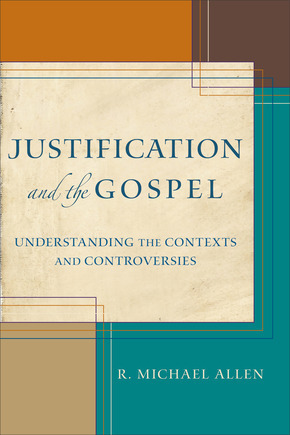Justin Taylor's Blog, page 132
November 6, 2013
One of the Reasons C.S. Lewis Remains So Widely Read 50 Years after His Death
Lewis’s unwavering commitment to what is True and Real and Valuable, as opposed to what is trendy or fashionable or current, has been another kind of liberation for me, namely, from “chronological snobbery.” He loved the wisdom of the ages, not the whimsy of the passing present. He called himself a Neanderthaler and a dinosaur.
He didn’t read newspapers.
He never wore a watch.
He never learned to type.
He did not own or drive a car.
He cared nothing about cutting a good appearance and wore the same old clothes until they were threadbare.
He was incredibly free from the addicting powers of the present moment.
The effect of this on me has been to make me wary of what he called “chronological snobbery.” That is, he has shown me that “newness” is no virtue, and “oldness” is no fault. He considered the present time to be provincial with its own blind spots. He said once: every third book you read should be from outside your own (provincial) century. Truth and beauty and goodness are not determined by when they exist. Nothing is inferior for being old, and nothing is valuable for being modern. This has freed me from the tyranny of novelty and opened for me the wisdom of the centuries.
J. I. Packer: How Systematic Theology Can Energize and Enrich Your Preaching
J. I. Packer’s lecture for the Simeon Course on Preaching and Systematic Theology:
November 5, 2013
When We Experience Nature as Being Touched by a Finger of that Right Hand at which There Are Pleasures Forevermore
C. S. Lewis:
We can’t—or I can’t—hear the song of a bird simply as a sound. Its meaning or message (“That’s a bird”) comes with it inevitably—just as one can’t see a familiar word in print as a merely visual pattern. The reading is as involuntary as the seeing. When the wind roars I don’t just hear the roar; I “hear the wind.” In the same way it is possible to “read” as well as to “have” a pleasure. Or not even “as well as.” The distinction ought to become, and sometimes is, impossible; to receive it and to recognize its divine source are a single experience. This heavenly fruit is instantly redolent of the orchard where it grew. This sweet air whispers of the country from whence it blows. It is a message. We know we are being touched by a finger of that right hand at which there are pleasures for evermore. There need be no question of thanks or praise as a separate event, something done afterwards. To experience the tiny theophany is itself to adore.
—Letters to Malcom
A Reading Plan for Augustine’s ‘The City of God’
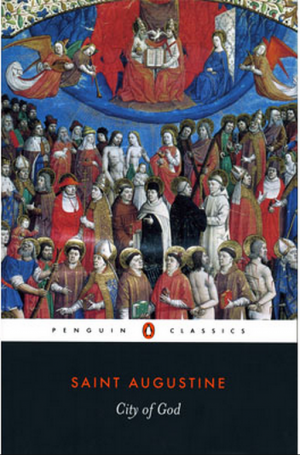 Augustine was Christianity’s first great political thinker. His seminal work, The City of God (full title: De Civitate Dei contra Paganos = The City of God against the Pagans), as Greg Forster writes, is ”the first real masterpiece of Christian political thought. Its analysis of the nature of politics has been one of the most prominent influences in Christian thinking, particularly in the West, in every era from its publication down to the present day. It is probably the most important work of Christian political thought ever produced.”
Augustine was Christianity’s first great political thinker. His seminal work, The City of God (full title: De Civitate Dei contra Paganos = The City of God against the Pagans), as Greg Forster writes, is ”the first real masterpiece of Christian political thought. Its analysis of the nature of politics has been one of the most prominent influences in Christian thinking, particularly in the West, in every era from its publication down to the present day. It is probably the most important work of Christian political thought ever produced.”
In the book, Augustine contrasts the city of God (civitas Dei) with the city of the world (civitas terrena). The “city” metaphors refer to people groups or societies comprised of like-minded individuals. The two peoples are fundamentally distinguished by their two kinds of loves: “the earthly city was created by self-love reaching the point of contempt for God, the Heavenly City by the love of God carried as far as contempt of self” (14.28). The fallen, earthly community is led by the flesh; the redeemed, other-worldly people by the Spirit. The earthly city seeks its good only in the created world, while the heavenly city seeks its highest good in God. The earthly city has a singular citizenship, while the heavenly city has a dual citizenship.
The City of God must be read against the backdrop of the sacking of Rome, where critics argued that Rome fell after it embraced Christianity and lost the protection of the gods. Augustine argued that the pagan critics were defining goodness on the basis of the satisfaction of their own desires, rather than the true definition which sees that the ultimate good is found in God alone. Augustine shows that everything in history happens for good purposes, if goodness is rightly understood. He pointed to the pagan desire to return to the city of Rome, and argued that their desire was right but their destination was wrong. True happiness could only come in the heavenly Jerusalem, the City of God.
One of the reasons that Augustine’s work remains unread today is because of its length and digressions. In lieu of an abridged version, Michael Haykin of Southern Seminary offers a selective reading guide to the book, which I’ve included below for those who want to take up one of the great classics of the Christian tradition.
A Reading Plan for The City of God
When I have lectured on Augustine’s seminal work, The City of God, I have often mentioned a reading plan I have for the work. Here it is below. The number prior to the full stop refers to the book (there are twenty-two books in The City of God), and the numbers after the full stop refer to the chapters within the respective books.
1.1-36: why Augustine wrote The City of God
4.1-4: the nature of kingdoms without justice
11.1-4: the origin of the two cities, the city of God and the city of man
12.4-9: the origin of evil
13.1-24: man’s fall and sinfulness
14.1-28: the two cities
15.1-2: the two cities at the beginning of time
20.1-30: the end of the two cities
21.1-2: the eternality of the punishment of the wicked
22.8-9: an excursus on miracles
22.29-30: the beatific vision
John Frame’s Systematic Theology: 50% Off
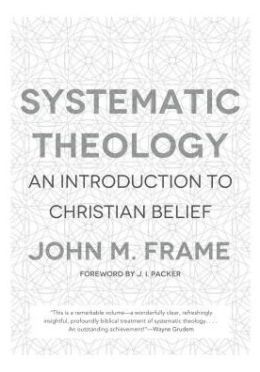 John Frame’s Systematic Theology (P&R, 2013) is now available (for a limited time at 50% off).
John Frame’s Systematic Theology (P&R, 2013) is now available (for a limited time at 50% off).
Here’s is a blurb I wrote for it:
“Here, at last, is John Frame’s magnum opus—the fruit of fifty years of teaching theology and training ministers of the gospel. Few other contemporary theologians have influenced me as much as Dr. Frame, and I am eager to see this culmination of his theological labors under the lordship of the triune God make its way into the heads, hands, and hearts of Christians around the world.”
Here are a few other commendations:
“He brings together a rare blend of big-picture thinking, levelheaded reflection, biblical fidelity, a love for the gospel and the church, and the ability to write with care and clarity.” (John Piper)
“This is a remarkable volume—a wonderfully clear, refreshingly insightful, profoundly biblical treatment of systematic theology.” (Wayne Grudem)
“This new systematic theology comes from one of the great theological minds of our age.” (Al Mohler)
“Clear, thorough, intelligent, and fair to opposing views, John Frame’s work will now be the standard within traditional Reformed theology.” (Cornelius Plantinga Jr.)
“John Frame is one of the most important evangelical theologians of our time, a deeply biblical thinker . . . I’ve long hoped that the Lord would grant Dr. Frame the opportunity and motivation to write a full-length systematic theology, and I’m delighted to see that hope now realized. This exposition of Christian doctrine is the culmination of a lifetime of careful and submissive reflection on the whole counsel of God revealed in Scripture. It will nourish both mind and heart.” (James N. Anderson)
“Few scholars of our generation have done as much as John Frame to combine philosophical, biblical, and confessional concerns in an overarching theological synthesis. Here at last he offers us the fruit of his lifetime’s labor as a service to the church of our day and to future generations. This is a work that will edify those who read it, and they in turn will use its message to build up the church of Christ. The wealth of teaching and insight that it contains will be a blessing to many, and we can be sure that it will be mightily used of God in the days ahead.” (Gerald L. Bray)
You can download J. I. Packer’s foreword, the table of contents, the preface, and the first chapter here.
November 4, 2013
A Book on Justification He Would Not Have Written Ten Years Ago
Ten years ago I certainly could not—would not—have written this book. I had been convinced that the Protestant doctrine of justification fared very poorly under the bar of exegetical and historical reason, and I was equally convinced that a dogmatic approach to anything was, well, going nowhere fast. I remember debating with parents, professors, pastors, and friends about these matters. I can completely identify now with the many critics of systematic theology and of the Protestant doctrine of justification; I was among them and zealous about it, spending more than my share of late nights as a student discussing these matters to the wee morning hours.
But now I have written Justification and the Gospel: Understanding the Contexts and Controversies, arguing that the Protestant doctrine of justification is exegetically defensible and theologically essential to filling out catholic teaching on God’s relations to creatures in the gospel of Jesus Christ. This book manifests something of the journey I’ve been on now for a decade. I found that rising familiarity with the exegetical riches of the great teachers of the church (from Irenaeus and Gregory to Thomas and Bonaventure to Luther and Calvin) shows their brilliance as aids and our own limits as modern researchers. I’ve also seen that too often protests regarding the Reformation stem from really bad understandings of what it actually involved, too frequently based in reading of poor secondary sources rather than in careful study of primary texts. I hope this book serves as a useful prompt to further reflection in these two conversations: how do we think well of justification in light of the wider gospel of Jesus? And how do we go about the task of Christian theology and of a faithful Christian reading of the Holy Scriptures today?
November 1, 2013
Max McLean Recites and Interprets the Entire Gospel of Mark
Below is Max McLean’s hour-long interpretation of the Gospel according to Mark, recited word-for-word from the NIV.
There is also a DVD edition of McLean’s one-man show, “Mark’s Gospel.” In 2009 I interviewed McLean about the production, when it was running as a live show in the Chicago Theater District.
I found this interpretation—absorbed in one sitting rather than piecemeal—to be an enriching, edifying experience.
October 31, 2013
An Interview with Carl Trueman on Luther’s 95 Theses
[image error]
Today is Halloween. But more importantly, it’s Reformation Day. It was on this day in 1517 (a Saturday) that a 33-year-old theology professor at Wittenberg University walked over to the Castle Church in Wittenberg and nailed a paper of 95 theses to the door, hoping to spark an academic discussion about their contents. In God’s providence and unbeknownst to anyone else that day, it would become a key event in igniting the Reformation.
I thought it might be helpful to ask a few questions of Carl Trueman, Professor of Historical Theology and Church History, and Academic Dean, at Westminster Theological Seminary in Philadelphia. Dr. Trueman wrote his dissertation on Luther’s Legacy, teaches on Luther’s life and theology, and is writing the volume on Luther for the Theologians on the Christian Life series, forthcoming from Crossway, edited by Steve Nichols and me.
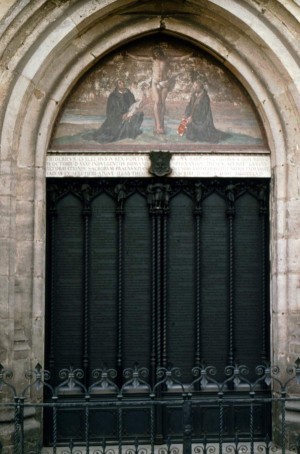
The door of the Schlosskirche (castle church) in Wittenberg, Germany.
Had Luther ever done this before—nail a set of theses to the Wittenberg door? If so, did previous attempts have any impact?
I am not sure if he had ever nailed up theses before, but he had certainly proposed sets of such for academic debate, which was all he was really doing on October 31, 1517. In fact, in September of that same year, he had led a debate on scholastic theology where he said far more radical things than were in the Ninety-Five Theses. Ironically, this earlier debate, now often considered the first major public adumbration of his later theology, caused no real stir in the church at all.
What was the point of nailing something to the Wittenberg door? Was this a common practice?
It was simply a convenient public place to advertise a debate, and not an unusual or uncommon practice. In itself, it was no more radical than putting up an announcement on a public notice board.
What precisely is a “thesis” in this context?
A thesis is simply a statement being brought forward for debate.
What was an “indulgence”?
An indulgence was a piece of paper, a certificate, which guaranteed the purchaser (or the person for whom the indulgence was purchased) that a certain amount of time in purgatory would be remitted as a result of the financial transaction.
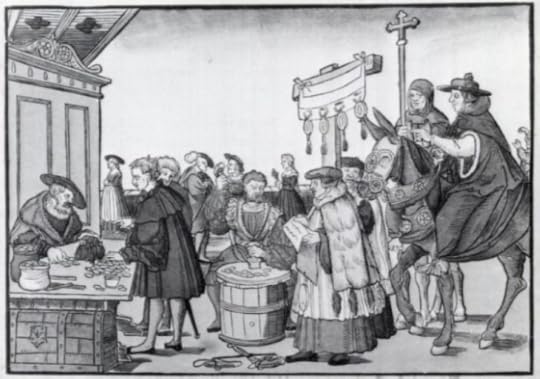
A woodcut by Jörg Breu the Elder of Augsburg (c. 1530) showing the sale of indulgences.
At this point did Luther have a problem with indulgences per se, or was he merely critiquing the abuse of indulgences?
This is actually quite a complicated question to answer.
First, Luther was definitely critiquing what he believes to be an abuse of indulgences. For him, an indulgence could have a positive function; the problem with those being sold by Johann Tetzel in 1517 is that remission of sin’s penalty has been radically separated from the actual repentance and humility of the individual receiving the same.
Second, it would appear that the Church herself was not clear on where the boundaries were relative to indulgences, and so Luther’s protest actually provoked the Church into having to reflect upon her practices, to establish what was and was not legitimate practice.
Was Luther trying to start a major debate by nailing these to the door?
The matter was certainly one of pressing pastoral concern for him. Tetzel was not actually allowed to sell his indulgences in Electoral Saxony (the territory where Wittenberg was located) because Frederick the Wise, Luther’s later protector, had his own trade in relics. Many of his parishioners, however, were crossing over into the neighboring territory of Ducal Saxony, where Tetzel was plying his trade.
Luther had been concerned about the matter of indulgences for some time. Thus, earlier in 1517, he had preached on the matter and consulted others for their opinions on the issue. By October, he was forced by the pastoral situation to act.
Having said all that, Luther was certainly not intending to split the church at this point or precipitate the Holy Roman Empire and the Papacy into conflict and crisis. He was simply trying to address a deep pastoral concern.
Was Luther a “Protestant” at this point? Was he a “Lutheran”?
No, on both counts. He himself tells us in 1545 that, in 1517, he was a committed Catholic who would have murdered—or at least been willing to see murder committed—in the name of the Pope. There is some typical Luther hyperbole there, but the theology of the Ninety-Five Theses is not particularly radical, and key Lutheran doctrines, such as justification by grace through faith alone, are not yet present. He was an angry Catholic, hoping that, when the Pope heard about Teztel, he would intervene to stop the abuse.
How did that act of nailing these theses to the door ignite the Reformation?
On one level, I am inclined to say “Goodness only knows.” As a pamphlet of popular revolution, it is, with the exception of the occasional rhetorical flourish, a remarkably dull piece of work which requires a reasonably sound knowledge of late medieval Catholic theology and practice even to understand many of its statements. Nevertheless, it seems to have struck a popular chord, being rapidly translated into German and becoming a bestseller within weeks. The easy answer is, therefore, “By the providence of God”; but, as a historian, I always like to try to tie things down to some set of secondary or more material causes.
Certainly, it was used in a way that appealed to popular anti-clericalism, resentment of the Roman curia, and a desire to stop money flowing out of German speaking territories to Rome. Yet, even so, the revolutionary power of such a technical composition is, in retrospect, still quite surprising.
For those today who want to read the 95 Theses, what would you recommend?
The place to start is probably Stephen Nichols’s edition (with an introduction and notes).
Nevertheless, if you really want to understand Luther’s theology, and why it is important, you will need to look beyond the Ninety-Five Theses. Probably the best place to start would be Robert Kolb and Charles P. Arand, The Genius of Luther’s Theology.

The illustrations above, painted by Greg Copeland, are used by permission of Concordia Publishing House and found in Paul Maier’s excellent book for older kids, Martin Luther: A Man Who Changed the World.
October 30, 2013
Greg Beale: “What Is Biblical Theology and Why Do We Need It?”
This is a helpful lecture from Greg Beale of Westminster Theological Seminary.
This is taken from lesson 1 of the Preaching and Biblical Theology curriculum as part of the Simeon Course on Biblical Exposition. Learn more here.
For those who want to take a great step in biblical theology, Jim Hamilton’s What Is Biblical Theology? A Guide to the Bible’s Story, Symbolism, and Patterns is now the place to start.
Justin Taylor's Blog
- Justin Taylor's profile
- 44 followers


